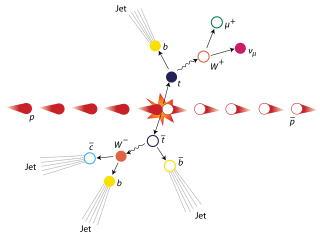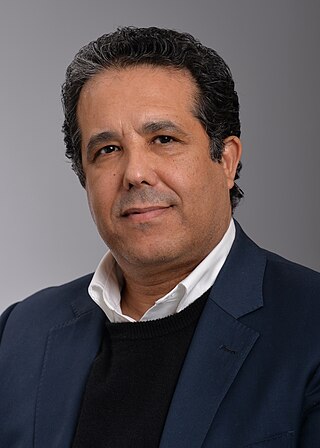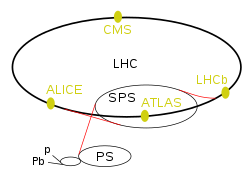Weakly interacting massive particles (WIMPs) are hypothetical particles that are one of the proposed candidates for dark matter.

The top quark, sometimes also referred to as the truth quark, is the most massive of all observed elementary particles. It derives its mass from its coupling to the Higgs Boson. This coupling is very close to unity; in the Standard Model of particle physics, it is the largest (strongest) coupling at the scale of the weak interactions and above. The top quark was discovered in 1995 by the CDF and DØ experiments at Fermilab.

The Large Hadron Collider (LHC) is the world's largest and highest-energy particle collider. It was built by the European Organization for Nuclear Research (CERN) between 1998 and 2008 in collaboration with over 10,000 scientists and hundreds of universities and laboratories across more than 100 countries. It lies in a tunnel 27 kilometres (17 mi) in circumference and as deep as 175 metres (574 ft) beneath the France–Switzerland border near Geneva.

ATLAS is the largest general-purpose particle detector experiment at the Large Hadron Collider (LHC), a particle accelerator at CERN in Switzerland. The experiment is designed to take advantage of the unprecedented energy available at the LHC and observe phenomena that involve highly massive particles which were not observable using earlier lower-energy accelerators. ATLAS was one of the two LHC experiments involved in the discovery of the Higgs boson in July 2012. It was also designed to search for evidence of theories of particle physics beyond the Standard Model.

The Large Electron–Positron Collider (LEP) was one of the largest particle accelerators ever constructed. It was built at CERN, a multi-national centre for research in nuclear and particle physics near Geneva, Switzerland.

The LHCb experiment is a particle physics detector experiment collecting data at the Large Hadron Collider at CERN. LHCb is a specialized b-physics experiment, designed primarily to measure the parameters of CP violation in the interactions of b-hadrons. Such studies can help to explain the matter-antimatter asymmetry of the Universe. The detector is also able to perform measurements of production cross sections, exotic hadron spectroscopy, charm physics and electroweak physics in the forward region. The LHCb collaboration, who built, operate and analyse data from the experiment, is composed of approximately 1260 people from 74 scientific institutes, representing 16 countries. Chris Parkes succeeded on July 1, 2020 as spokesperson for the collaboration from Giovanni Passaleva. The experiment is located at point 8 on the LHC tunnel close to Ferney-Voltaire, France just over the border from Geneva. The (small) MoEDAL experiment shares the same cavern.

The DØ experiment was a worldwide collaboration of scientists conducting research on the fundamental nature of matter. DØ was one of two major experiments located at the Tevatron Collider at Fermilab in Batavia, Illinois. The Tevatron was the world's highest-energy accelerator from 1983 until 2009, when its energy was surpassed by the Large Hadron Collider. The DØ experiment stopped taking data in 2011, when the Tevatron shut down, but data analysis is still ongoing. The DØ detector is preserved in Fermilab's DØ Assembly Building as part of a historical exhibit for public tours.
Leptoquarks are hypothetical particles that would interact with quarks and leptons. Leptoquarks are color-triplet bosons that carry both lepton and baryon numbers. Their other quantum numbers, like spin, (fractional) electric charge and weak isospin vary among models. Leptoquarks are encountered in various extensions of the Standard Model, such as technicolor theories, theories of quark–lepton unification (e.g., Pati–Salam model), or GUTs based on SU(5), SO(10), E6, etc. Leptoquarks are currently searched for in experiments ATLAS and CMS at the Large Hadron Collider in CERN.
T2K is a particle physics experiment studying the oscillations of the accelerator neutrinos. The experiment is conducted in Japan by the international cooperation of about 500 physicists and engineers with over 60 research institutions from several countries from Europe, Asia and North America and it is a recognized CERN experiment (RE13). T2K collected data within its first phase of operation from 2010 till 2021. The second phase of data taking (T2K-II) is expected to start in 2023 and last until commencement of the successor of T2K – the Hyper-Kamiokande experiment in 2027.
The High Luminosity Large Hadron Collider is an upgrade to the Large Hadron Collider, operated by the European Organization for Nuclear Research (CERN), located at the French-Swiss border near Geneva. From 2011 to 2020, the project was led by Lucio Rossi. In 2020, the lead role was taken up by Oliver Brüning.

The LHCf is a special-purpose Large Hadron Collider experiment for astroparticle physics, and one of nine detectors in the LHC accelerator at CERN. LHCf is designed to study the particles generated in the forward region of collisions, those almost directly in line with the colliding proton beams.

MoEDAL is a particle physics experiment at the Large Hadron Collider (LHC).

The search for the Higgs boson was a 40-year effort by physicists to prove the existence or non-existence of the Higgs boson, first theorised in the 1960s. The Higgs boson was the last unobserved fundamental particle in the Standard Model of particle physics, and its discovery was described as being the "ultimate verification" of the Standard Model. In March 2013, the Higgs boson was officially confirmed to exist.

The Future Circular Collider (FCC) is a proposed particle accelerator with an energy significantly above that of previous circular colliders, such as the Super Proton Synchrotron, the Tevatron, and the Large Hadron Collider (LHC). The FCC project is considering three scenarios for collision types: FCC-hh, for hadron-hadron collisions, including proton-proton and heavy ion collisions, FCC-ee, for electron-positron collisions, and FCC-eh, for electron-hadron collisions.

]

Kamal Benslama is a Moroccan-Swiss experimental particle physicist. He is a professor of physics at Drew University, a visiting experimental scientist at Fermilab, and a guest scientist at Brookhaven National Laboratory. He worked on the ATLAS experiment, at the Large Hadron Collider (LHC) at CERN in Switzerland, which is considered the largest experiment in the history of physical science. At present, he is member of the MU2E collaboration at Fermi National Accelerator Laboratory (Fermilab), located just outside Batavia, Illinois, near Chicago. Fermilab is a United States Department of Energy national laboratory specializing in high-energy particle physics.

A fixed-target experiment in particle physics is an experiment in which a beam of accelerated particles is collided with a stationary target. The moving beam consists of charged particles such as electrons or protons and is accelerated to relativistic speed. The fixed target can be a solid block or a liquid or a gaseous medium. These experiments are distinct from the collider-type experiments in which two moving particle beams are accelerated and collided. The famous Rutherford gold foil experiment, performed between 1908 and 1913, was one of the first fixed-target experiments, in which the alpha particles were targeted at a thin gold foil.

The Scattering and Neutrino Detector (SND) at the Large Hadron Collider (LHC), CERN, is an experiment built for the detection of the collider neutrinos. The primary goal of SND is to measure the p+p --> +X process and search for the feebly interacting particles. It will be operational from 2022, during the LHC-Run 3 (2022-2024). SND will be installed in an empty tunnel- TI18 that links the LHC and Super Proton Synchrotron, 480m away from the ATLAS experiment interaction point in the fast forward region and along the beam collision axis.
The Search for Hidden Particle (SHiP) is a fixed-target experiment at CERN's Super Proton Synchrotron (SPS) with the goal of searching for the interactions and measurements of the weakly interacting particles. In October 2013, the Expression of Interest letter for SHiP was submitted to the SPS Council (SPSC). Following which the Technical Proposal was submitted in April 2015, describing the experimental and detector facility. The Comprehensive Design Study was completed during 2016-19.












